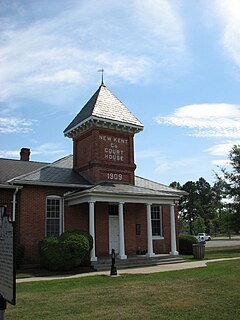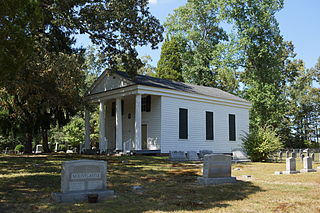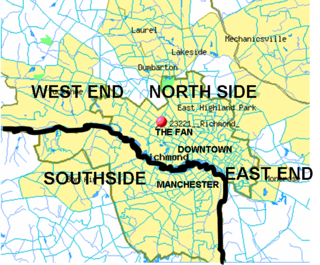
Providence Forge is an unincorporated community in New Kent County, Virginia, United States. It was one of the earliest settlements in the county (itself formed by 1654) and the site of a colonial iron forge that was destroyed by British General Banastre Tarleton during the American Revolutionary War.

In law, an unincorporated area is a region of land that is not governed by a local municipal corporation; similarly an unincorporated community is a settlement that is not governed by its own local municipal corporation, but rather is administered as part of larger administrative divisions, such as a township, parish, borough, county, city, canton, state, province or country. Occasionally, municipalities dissolve or disincorporate, which may happen if they become fiscally insolvent, and services become the responsibility of a higher administration. Widespread unincorporated communities and areas are a distinguishing feature of the United States and Canada. In most other countries of the world, there are either no unincorporated areas at all, or these are very rare; typically remote, outlying, sparsely populated or uninhabited areas.

New Kent County is a county in the eastern part the Commonwealth of Virginia. As of the 2010 United States Census, the population was 18,429. Its county seat is New Kent.

Virginia, officially the Commonwealth of Virginia, is a state in the Southeastern and Mid-Atlantic regions of the United States located between the Atlantic Coast and the Appalachian Mountains. The geography and climate of the Commonwealth are shaped by the Blue Ridge Mountains and the Chesapeake Bay, which provide habitat for much of its flora and fauna. The capital of the Commonwealth is Richmond; Virginia Beach is the most populous city, and Fairfax County is the most populous political subdivision. The Commonwealth's estimated population as of 2018 is over 8.5 million.
Nearby, the Chickahominy River separates New Kent from Charles City County. U.S. Route 60 and State Route 155 pass through Providence Forge. The Colonial Downs horse-racing facility is located nearby adjacent to the Providence Forge exit of Interstate 64.

The Chickahominy is an 87-mile-long (140 km) river in the eastern portion of the U.S. state of Virginia. The river, which serves as the eastern border of Charles City County, rises about 15 miles (24 km) northwest of Richmond and flows southeast and south to the James River. The river was named after the Chickahominy Indian tribe who lived near the river when it was claimed by English colonists in 1607. Chickahominy descendants live in Charles City County today.

Charles City County is a historic county located in the U.S. commonwealth of Virginia. The county is situated southeast of Richmond and west of Jamestown. It is bounded on the south by the James River and on the east by the Chickahominy River.

Colonial Downs is a racetrack located in New Kent County, Virginia adjacent to Interstate 64, halfway between Richmond and Williamsburg. The track conducted Thoroughbred flat racing and Standardbred harness racing between 1997 and 2014. It is owned by the Colonial Downs Group.
A station on the Chesapeake and Ohio Railway (C&O) was located at Providence Forge in 1881 during construction of the railroad's new Peninsula Subdivision, which was built primarily to facilitate transportation of West Virginia bituminous coal to the newly created city of Newport News. There, on the harbor of Hampton Roads, coal piers were built to load colliers for worldwide export shipment. [1]

The Chesapeake and Ohio Railway was a Class I railroad formed in 1869 in Virginia from several smaller Virginia railroads begun in the 19th century. Led by industrialist Collis P. Huntington, it reached from Virginia's capital city of Richmond to the Ohio River by 1873, where the railroad town of Huntington, West Virginia was named for him.

West Virginia is a state located in the Appalachian region in the Southern United States that is also considered to be a part of the Middle Atlantic States. It is bordered by Pennsylvania to the north, Maryland to the east and northeast, Virginia to the southeast, Kentucky to the southwest, and Ohio to the northwest. West Virginia is the 41st largest state by area, and is ranked 38th in population. The capital and largest city is Charleston.

Bituminous coal or black coal is a relatively soft coal containing a tarlike substance called bitumen or asphalt. It is of higher quality than lignite coal but of poorer quality than anthracite. Formation is usually the result of high pressure being exerted on lignite. Its coloration can be black or sometimes dark brown; often there are well-defined bands of bright and dull material within the seams. These distinctive sequences, which are classified according to either "dull, bright-banded" or "bright, dull-banded", is how bituminous coals are stratigraphically identified.
The C&O's Peninsula Extension was good news for the farmers and merchants of the Virginia Peninsula, and they generally welcomed the railroad. Providence Forge was a stop for passengers until about 1931 and for freight until at least the late 1960s, according to the Chesapeake & Ohio Historical Society. The structure was dismantled sometime in 2006. The only similar structure, at Lee Hall, has been preserved and efforts were underway in 2008 to relocate it slightly away from the right-of-way and open it as a museum. [2]

The Peninsula Extension which created the Peninsula Subdivision of the Chesapeake and Ohio Railway (C&O) was the new railroad line on the Virginia Peninsula from Richmond to southeastern Warwick County. Its principal purpose was to provide an important new pathway for coal mined in West Virginia to reach the harbor of Hampton Roads for coastal and export shipping on collier ships.

The Virginia Peninsula is a peninsula in southeast Virginia, USA, bounded by the York River, James River, Hampton Roads and Chesapeake Bay. It is sometimes known as the Lower Peninsula to distinguish it from two other peninsulas to the north, the Middle Peninsula and the Northern Neck.

Lee Hall is a former unincorporated town long located in the former Warwick County. Since 1958, Lee Hall has been a suburban community in the extreme western portion of the independent city of Newport News in the Commonwealth of Virginia.
Cedar Grove, Emmaus Baptist Church, Olivet Presbyterian Church, and Spring Hill are listed on the National Register of Historic Places. [3]

Cedar Grove is a historic plantation house located near Providence Forge, New Kent County, Virginia. The main section was built about 1810, and is a 2 1/2-story, single pile, brick structure. The frame section was added about 1916. It has a traditional one-room side-hall plan. Also on the property are a contributing smokehouse and several sheds added about 1916. It was the farm residence of the Christians, a leading county family of colonial and early-Republican times. The 19th-century cemetery contains the graves of the Christian family, including Letitia Christian Tyler, the first wife of President John Tyler.

Emmaus Baptist Church is a historic Southern Baptist church located near Providence Forge, New Kent County, Virginia. It was built between 1849 and 1852, and is a rectangular, simple nave- plan structure in the Greek Revival style. It measures 38 feet wide by 50 feet long. Also on the property is a contributing church cemetery that contains 195 tombstones with dates ranging from 1855 to 1989.

Olivet Presbyterian Church is a historic Presbyterian church located near Providence Forge, New Kent County, Virginia. It was built in 1856, and is a small frame church building in the Greek Revival style. It features a flush-boarded, pedimented portico with four fluted Greek Doric order columns.














